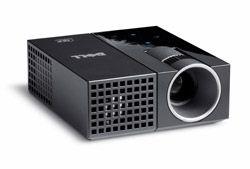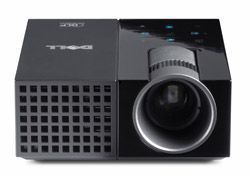Laptop Mag Verdict
This Lilliputian projector has the brightest LED in its class yet.
Pros
- +
Very small and light
- +
Fast warm-up and cooldown times
- +
Uses same AC adapter as Dell laptops
Cons
- -
Requires dark environment
- -
Difficult to press buttons on projector's top panel
- -
Nonstandard native resolution
Why you can trust Laptop Mag
In June 2005 Mitsubishi introduced the first projector to use LEDs as a light source. This groundbreaking product was so efficient that it could run on its own battery. Unfortunately it was also barely brighter than a lit match. Now almost four years after that first LED projector appeared, here is one that is bright enough for use in special situations. The $499 Dell M109S may not be the most versatile ultraportable projector on the market--nor is it nearly as tiny as so-called pico projectors from 3M and Optoma--but it's impressive to see how much Dell has packed into such a small package.
Design
The Dell M109S, at 4.1 x 3.6 x 1.5 inches, is a small rectangular box reminiscent of jewelry-store watch boxes. The glossy black plastic exterior is interrupted by the barest minimum of controls and connectors. On the top panel is a knurled ring for focusing and a set of nine membrane buttons for accessing the projector's on-screen menu. The back panel reveals a single, small, narrow connector. A hydra-like adapter cable links this connector to an AC power outlet, a laptop VGA connector, and a composite video cable.
Interestingly, the M109S uses the same AC adapter as Dell's current laptops. This means if you have a Dell notebook, you can leave the projector's AC adapter at home and run the projector from your notebook's adapter while the laptop runs on battery.
Controls

Click to enlargeWith no remote control, the membrane buttons on the M109S are the only ways to control the projector. These buttons were hard to use: with no physical feedback, it is far too easy to press a button too lightly (for no response) or too heavily (for unwanted responses in underlying menus).For example, we accidentally changed the language to German, and it was only by the help of an old college German I class that we could navigate back to English. It should be noted that this projector has so few options that most users will never need to access the menu.
LED Light Performance

Click to enlargeUnlike the manufacturers of previous LED projectors--who often went out of their way to obfuscate their limited luminosity--Dell is quite up front about the M109S' capability of only 50 ANSI lumens of brightness. Of course, this is almost two orders of magnitude lower than the brightness offered by larger, relatively stationary projectors, yet it is bright enough for some limited applications where a presenter can control the ambient light, as in a darkened conference room.
LED projectors have had a spotty reputation in our lab. Some were so dim that they didn't even register on our brightness meters. The M109S, by contrast, was a pleasure to test. In fact, this model achieved the rare distinction of actually being brighter than advertised, checking in at 59 lumens--almost 20 percent better than claimed. But as usual for all projectors, our checkerboard contrast test showed results that were lower than claimed. We saw a contrast ratio of only 125:1, which is lower than most of the models we've tested, but not bad for a projector of this petite size.
Fan Required
LED lamps are so efficient that they produce little heat, and up to now, LED projectors did not require a cooling fan. But because this model is approximately twice as bright as previous LED projectors, the M109S does require a cooling fan. This fan is loud enough to be noticeable without being objectionable, and the cooldown time is a remarkably short 17 seconds.
Unorthodox Resolution

Click to enlargeFocusing was somewhat difficult, but once we got the image focused, the image was relatively sharp--or as sharp as it could be for its resolution. Regrettably, the M109S has a nonstandard native resolution of 858 x 600. This means that even a laptop set at the roughly similar SVGA resolution (800 x 600) will not match up exactly with this projector. When the M109S converts an 800-pixel-wide SVGA image into one that is 858 pixels wide, the extrapolation process results in about every seventh pixel being a bit fuzzy. Dell tells us that they had to use a DLP chip at this unusual resolution because of the small size of this projector. The end result is that the M109S does fairly well with PowerPoint slides and TV, but presenters should avoid any small type.
Verdict
We doubt the Dell M109S projector will put a crimp in sales of larger and significantly brighter models, but weighing less than 2 pounds even with its power adapter it could be very successful in ultra-mobile applications. We see it linking nicely with, say, an Apple iPod, for impromptu presentations and movie showings. At $499, the M109S is relatively expensive considering its limited luminosity, but its small size marks a big step forward for ultraportable projectors.
Dell M109S Specs
| Brightness | Less than 2000 Lumens |
| Company Website | http://www.dell.com |
| Contrast Ratio | Less than 500:1 |
| Cool Down Time | 17 seconds |
| Image Engine | 0.45-inch DLP DMD Type Y chip |
| Input Terminals | RGB-In, Composite Video |
| Projector Resolution | 858 x 600 |
| Projector Technology | LCD |
| Size | 4.1 x 3.6 x 1.5 inches |
| Supported Formats | NTSC, 480p, N-PAL, 480i, M-PAL, 1080i, HDTV, SECAM, 720p, PAL, 576p, NTSC 4.43, 576i |
| Video Inputs | Composite |
| Weight | (projector/travel): 0.8 pounds/1.8 pounds |
| Zoom Focus | None/Manual |
